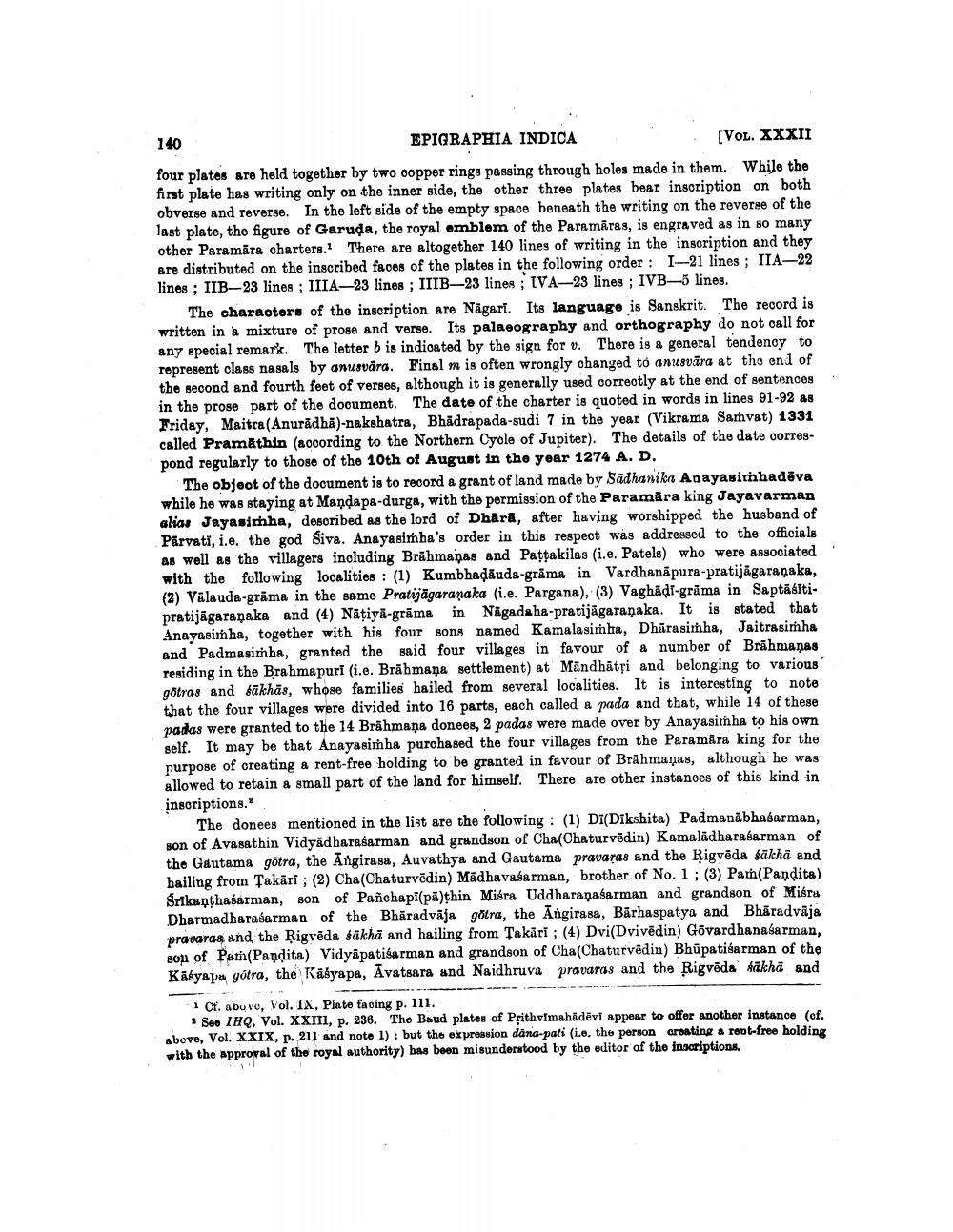________________
140
EPIGRAPHIA INDICA
[VOL. XXXII
four plates are held together by two copper rings passing through holes made in them. While the first plate has writing only on the inner side, the other three plates bear inscription on both obverse and reverse. In the left side of the empty space beneath the writing on the reverse of the last plate, the figure of Garuda, the royal emblem of the Paramaras, is engraved as in so many other Paramāra charters. There are altogether 140 lines of writing in the inscription and they are distributed on the inscribed faces of the plates in the following order: I-21 lines; IIA-22 lines; IIB-23 lines; IIIA-23 lines; IIIB-23 lines; IVA-23 lines; IVB-5 lines.
The characters of the inscription are Nagari. Its language is Sanskrit. The record is written in a mixture of prose and verse. Its palaeography and orthography do not call for any special remark. The letter b is indicated by the sign for v. There is a general tendency to represent class nasals by anusvära. Final m is often wrongly changed to anusvara at the end of the second and fourth feet of verses, although it is generally used correctly at the end of sentences in the prose part of the document. The date of the charter is quoted in words in lines 91-92 as Friday, Maitra (Anuradha)-nakshatra, Bhadrapada-sudi 7 in the year (Vikrama Samvat) 1331 called Pramathin (according to the Northern Cycle of Jupiter). The details of the date correspond regularly to those of the 10th of August in the year 1274 A. D.
The object of the document is to record a grant of land made by Sadhanika Anayasimhadeva while he was staying at Mandapa-durga, with the permission of the Paramāra king Jayavarman alias Jayasimhha, described as the lord of Dhärä, after having worshipped the husband of Parvati, i.e. the god Siva. Anayasimha's order in this respect was addressed to the officials as well as the villagers including Brahmanas and Paṭṭakilas (i.e. Patels) who were associated with the following localities: (1) Kumbhadauda-grāma in Vardhanapura-pratijāgaraṇaka, (2) Välauda-grāma in the same Pratijägaranaka (i.e. Pargana), (3) Vaghadi-grāma in Saptaśltipratijāgaranaka and (4) Naṭiya-grāma in Nagadaha-pratijägaranaka. It is stated that Anayasimha, together with his four sons named Kamalasimha, Dharasimha, Jaitrasimha and Padmasimha, granted the said four villages in favour of a number of Brahmanas residing in the Brahmapuri (i.e. Brahmaņa settlement) at Mändhātri and belonging to various" götras and bakhas, whose families hailed from several localities. It is interesting to note that the four villages were divided into 16 parts, each called a pada and that, while 14 of these padas were granted to the 14 Brahmana donees, 2 padas were made over by Anayasimha to his own self. It may be that Anayasimha purchased the four villages from the Paramāra king for the purpose of creating a rent-free holding to be granted in favour of Brahmanas, although he was allowed to retain a small part of the land for himself. There are other instances of this kind in inscriptions.
The donees mentioned in the list are the following: (1) Di(Dikshita) Padmanabhaśarman, son of Avasathin Vidyadharaśarman and grandson of Cha(Chaturvedin) Kamalädharasarman of the Gautama götra, the Angirasa, Auvathya and Gautama pravaras and the Rigveda sākhā and hailing from Takārī; (2) Cha(Chaturvēdin) Madhavasarman, brother of No. 1; (3) Pam(Pandita) Srikanthasarman, son of Pañchapi(pa)thin Miśra Uddharanasarman and grandson of Miśra Dharmadharasarman of the Bharadvaja gotra, the Angirasa, Barhaspatya and Bharadvaja pravaras and the Rigveda sākhā and hailing from Takari; (4) Dvi(Dvivēdin) Govardhanasarman, son of Pam(Pandita) Vidyapatisarman and grandson of Cha(Chaturvedin) Bhupatisarman of the Kasyapa gotra, the Kasyapa, Avatsara and Naidhruva pravaras and the Rigveda sakha and
1 Cf. above, Vol. IX, Plate facing p. 111.
See IHQ, Vol. XXIII, p. 236. The Baud plates of Prithvimahadevi appear to offer another instance (of. above, Vol. XXIX, p. 211 and note 1); but the expression dana-pati (i.e. the person areating a rent-free holding with the approval of the royal authority) has been misunderstood by the editor of the inscriptions.




